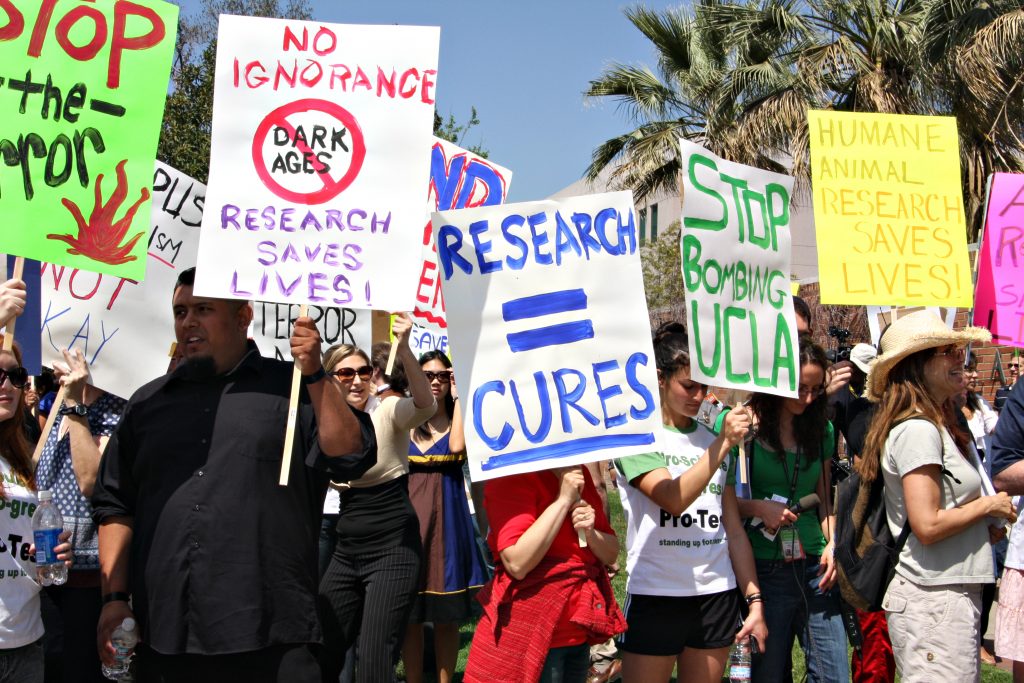Many people may not know this, but animal research has played an important role in almost every major medical advancement of the last century. The list includes antibiotics, blood transfusions, chemotherapy, dialysis, insulin, organ transplantation, heart bypass surgery, joint replacement, vaccinations, how a cancer gene works, new vaccines, and many more treatments that help stop suffering.1 These treatments are based on knowledge attained through research with lab animals. We have been able to learn and understand a great deal in the field of science and medicine through this testing; however, it has been at the expense of innocent animals. Although there are alternatives to animal testing, living organisms are very complex, and the only way to learn more is through research on other complex organisms that possess the same traits.
The many discoveries that have occurred, based on animal testing in the nineteenth century, have had a significant impact on how we live and view medicine. There are still a lot of questions, and even unknown questions in the field of science and medicine, that can benefit us in the same way they have in the past; therefore, animal testing should be continued for this purpose only. There are laws that protect animals and the amount that can be used and how they are treated to prevent cruelty. Many people who test on animals conduct their research with the obligation to keeping the animal safe. Their research uses as few animals as possible, and only when necessary, and in designed experiments that yield valid results and use the best possible methods and treatments.

Animal experiments were used in the discovery of anesthesia. Humphrey Davy demonstrated that nitrous oxide produced a reversible state of unconsciousness in animals. Through many trials, Davy led to the conclusion that animals could survive for long periods in an atmosphere of nitrous oxide mixed with air, and he consistently inhaled the gas himself. He noted on one trial that the gas actually relieved his toothache. In his book, published in 1800, Davy concludes: “As nitrous oxide in its extensive operation appears capable of destroying physical pain, it may probably be used with advantage during surgical operations in which no great effusion of blood takes place.”2 Later on, in the 1820s, Dr. Henry Hickman continued the experiments a stage further by performing surgery on animals under a state of carbon dioxide or nitrous oxide. Hickman tried to interest the medical field in the possibility of preventing pain during surgery by inhalation of these gases. However, he was ignored. More than twenty years later, the dentist Horace Wells, under nitrous oxide anesthesia, had a wisdom tooth removed by his partner Riggs. The nitrous oxide was administered by Quincy Colton, who was a medical student making his living by exploring the effects of laughing gas on members of the audience at stage shows.3 Before the laughing gas parties or ether frolic in the 1840s, the work of perfecting general anesthesia was already in play and being tested on animals.

Another critical discovery, very prominent in the lives of many today, is insulin. Studies using experimentally-induced animal models of diabetes were done to discover that insulin could be used to treat diabetes.4 The experiments began in 1921 by Frederick Banting and Charles Best. They began experimenting by removing the pancreas from a dog. The dog became thirsty, drank lots of water, and urinated more often. The dog became weaker and weaker. They found that this was due to the removal of sugars from the urine of the dog, whose pancreas had been previously removed, which is a typical animal model of diabetes. Experimenting on another dog, Banting and Best surgically ligated the pancreas, which stopped the flow of nourishment. This was so that the pancreas degenerated. After some time, they removed the pancreas, sliced it up, and froze the pieces in a mixture of water and salts.5 When the pieces were half frozen, they were ground up and filtered. The isolated substance was named “isletin.” This extract was then injected into the diabetic dog. Its blood glucose level dropped, and it seemed healthier and stronger. By giving a diabetic dog a few injections a day, Banting and Best could keep it healthy and free of symptoms.6 With continuing research, however, the extracts were found to be toxic. This caused a serious fever in both the dogs and diabetic patients. A biochemist named James Collip partnered with them and prepared insulin from the pancreas’ of cows and pigs. James Collip used alcohol to extract insulin, which produced several different protein solutions. He then needed to find out how much insulin was present in each solution. This was done by measuring their activity by injecting each solution into rabbits and monitoring their blood sugar levels. Collip developed a measure of activity based on the ability of the extract to lower blood sugar in the rabbit, which was used to standardize extracts. The three scientists, Collip, Banting, and Best’s extracts were used successfully in dogs and then in patients in 1922 with exceptional results. Millions today depend on this discovery, because insulin helps keeps blood sugar levels from getting too high or too low. Insulin regulates how the body uses and stores glucose and fat, and many of the body’s cells rely on it to take glucose from the blood for energy. It is very important and many people who have diabetes depend on this discovery.

Moreover, like many medical advances, the making of the heart-lung machine depended heavily on animal research.7 The cardiopulmonary bypass pump, or heart-lung machine, can take on the role of the heart and lungs during cardiac surgery. Opening up a person and being able to operate on a heart is extremely difficult and requires precise movements. As with any surgery, any wrong move or wrong cut can cause severe damage and even death. The machine allows for blood to bypass the heart while surgeons work. It is attached to the veins that feed the heart and to the arteries that leave it, where it draws blood from a patient just before it reaches the heart.8 In 1931, John Gibbon began to investigate the possibility of building an external device that could do the job of the heart and lungs for a short period of time. The research initially began using cats and developing a machine that could replace the function of a cat’s heart and lungs for twenty minutes.9 Unfortunately, not many of the cats survived longer that twenty-three days after surgery. Gibbon’s World War II army service in the China-Burma-INBM Theater temporarily interrupted his research. The research then continued with dogs, where initially the survival rates were low. He used a new series of experiments with dogs in the 1950s, using IBM-built machines. The new device used a new method of cascading the blood down a thin sheet of film for oxygenation, instead of the original technique that could potentially damage blood corpuscles. These experiments revealed the need to add filters to the heart-lung device to prevent blood clots. The dogs began surviving and the heart-lung machine was eventually prepared for use in humans. In 1953, the first successful operation on a human, using the heart-lung machine, was performed. Cecelia Bavolek underwent an open-heart bypass surgery, where the machine totally supported her heart and lung functions for more than half the duration.10 Today, this machine, which was perfected through many animal experiments, is commonly used to do the job of the heart and lungs for many hours, allowing for complex cardiac surgeries to take place. This machine is also used in keeping patients alive during heart transplants, and supported premature babies.
Animal testing has helped researchers discover or improve drugs and treatments, which have improved health and medicine. As mentioned, many medical treatments that many people heavily depend on today have been made possible by animal testing. Scientists and researchers are, of course, not allowed to experiment on humans, so the other route to go is on animals. In fact, 71 of the Nobel Prizes for Medicine won in the last 103 years were awarded to scientists who used animals in their research. There is still a lot to learn in the field of science and medicine, so animal research is still necessary in order for there to be advances.
- Salem Press Encyclopedia, January 2016, s.v. “Animal Testing,” by Joel McClellan. ↵
- R. Sharpe, The Cruel Deception, Chemical and Philosophical, The Chiefly Concerning Nitrous Oxide (Johnson: London, 1800), 159. ↵
- Thomson Guedes, The Self-trained pioneer Anesthesiology (JC, 1956), 93. ↵
- Michael Bliss, The Discovery of insulin (Chicago: University of Chicago Press, 2007), 304. ↵
- Subbroto Kumar Saha, “Recent Advances in Disease Modeling and Drug Discovery for Diabetes Mellitus Using Animals,” International Journal of Molecular Sciences 17, no. 2 (2016): 14. ↵
- Nobel Media, February 2009, s.v. “The Discovery of Insulin.” ↵
- “Animal Testing is crucial for science,” The Belfast Telegraph (Belfast, Northern Ireland 2016). ↵
- Andreia Cristina Passaroni, “Cardiopulmonary bypass: development of John Gibbon’s heart-lung machine,” The Brazilian Journal of Cardiovascular Surgery 30, no. 2 (2015): 238. ↵
- Andreia Cristina Passaroni, “Cardiopulmonary bypass: development of John Gibbon’s heart-lung machine,” Brazilian Journal of Cardiovascular Surgery 30, no. 2 (2015): 238. ↵
- Walter Gomes, “The Brazilian Registry of Adult Patient Undergoing Cardiovascular Surgery, the Bypass Project,” Brazilian Journal of Cardiovascular Surgery 32, no.2 (April 2017): 73. ↵



82 comments
Jackie Velasquez
As a person who wants to become a veterinarian and care for animals, this article was very interesting. I am not a fan of animal testing as it can cause harm, however I do realize that because of animal testing, there have been many discoveries that have helped us with out diseases today. I do realize that although there may cons, there are also pros that weigh out the cons. This article really opened my eyes to how beneficial animal testing may be.
Caily Torres
Animal testing is a very controversial topic which is why this article caught my attention. Animal testing is an ethical issue, most people think it is cruel to use innocent animals for scientific purposes. However, this article presented another side of animal testing that most people tend to forget. Animal testing has lead to the discovery of anesthesia, insulin, vaccines, and so much more. I understand that is ethically wrong to test on innocent animals, but it is also ethically wrong to test on humans. Without this practice, the medical world would be drastically different and the truth is we would probably be dying of disease.
Franchesca Baldwin
Although this is a controversial subject, it’s an important topic to be discussed. There will always be people who abuse powers granted to them, whether on small or large scales, but this doesn’t mean that these are people within the majority. So much of the animal testing going on currently and in past decades has been unnecessary, however animal testing has yielded lifesaving inventions over and over again, making this a discussion which requires compromise on the conditions we can subject these animals to.
Lesley Martinez
Animal testing is always a controversial topic. The use of animals has helped in the invention of new medicine for the betterment of society. The invention of Dr. Humphrey Davy to use nitrous oxide is interesting since it wasn’t used until the 1840s. Additionally, the story of how insulin was created is so interesting. I had no idea that Frederick Banting and Charles Best were able to remove the pancreas from a dog and inject “isletin” into the dog to measure its blood sugar levels. I can see how animals can help the medical field, so I’m glad that there are laws that protect animals and prevent cruelty.
Alexis Aranda
Animal testing has and will probably always be a controversial topic. This article was very eye opening for me personally, because I LOVE animals with my entire being and hate thinking about them coped up, scared, and being forced to be injected with harsh chemicals that could potentially hurt them. I, however, understand why so many scientists still do so. I can understand that many advances have been done because of animal testing. Though I wish we could find a faster, more efficient and less painful way of testing, I believe that is is, at least for right now, is our only option.
Kenneth Gilley
I can see why animal testing is a controversial topic, however, as the article really does provide some interesting food for thought. Without testing things like antibiotics, chemotherapy, insulin, and vaccinations on animals, we would have two alternatives: we could test them on humans, which would be so dangerous as to be unethical in almost every case, or we could simply throw potentially life-saving cures away.
Luis Arroyos
This article is very informative, I never knew the impact animal research has had on our medical advancements. I think it is important information one needs to comprehend before reacting to this contentious topic. It shined a new light on the topic that I have always visualized as negative. Although, I think there is still obvious boundaries that must not be crossed, such as animal testing for something so insignificant such as make-up products.
Breanna Ortiz
I enjoyed reading this article because it really presents another aspect of animal testing. We see in tabloids or movies how people protest animal cruelty rights and animal testing, but they fail to keep an open mind. Not all animal testing is to cause harm it is used more to research the possible effects of different diseases on humans. This article did a great job on explaining and emphasizing that as well.
Ilse Amaya
This article gave me a new perspective on animal testing in the field of medicine. I understand how controversial it can be nowadays, but we never look back and appreciate what animals helped us discover a few years ago. Things mentioned in the article like insulin, and anesthesia are used daily in the field of medicine and our world will be totally different without it.
Breanna Perry
This article was nicely written and explained the importance of animal research very well. I have always been an advocate for using animals as test subjects for life-changing discoveries. It was interesting to learn from this article that insulin and anesthesia were discovered through the use of animals. If that doesn’t convince anyone, along with the many other major discoveries, that it is important to test on animals, I’m not sure what will. I understand that some people view animals as innocent, but either we test on them or us. This article does a good job explaining the reasoning and benefits from animal testing.